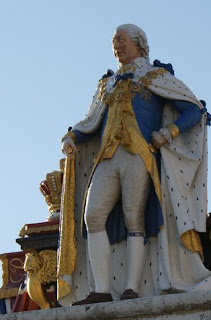 |
| George III from Memoirs of Queen Charlotte by WC Oulton (1819) |
George III (4 June 1738 - 29 January 1820) was the third Hanoverian King of Great Britain. He reigned from 25 October 1760 to 29 January 1820 and is still the longest reigning British King. He is most remembered for his 'madness' which led to his eldest son, the future George IV, being made Regent in 1811.
The reign of George III
George III was born on 4 June 1738, the eldest son of Frederick, Prince of Wales, and Augusta of Saxe-Gotha. He became heir to the throne on 20 March 1751 on the death of his father, and became King on 25 October 1760 on the death of his grandfather, George II. He was crowned in Westminster Abbey on 22 September 1761.
Unlike his Hanoverian predecessors, he was born and raised in England. He was a conscientious ruler who worked hard to govern the country by constitutional means, and managed to have good working relationships with most of his prime ministers.
Family Life
On 8 September 1761, shortly before his coronation, George married Charlotte of Mecklenburg-Strelitz, having met her only a few hours before the ceremony. Despite this, it was a successful marriage, producing fifteen children including two future monarchs, George IV and William IV.
 |
| Queen Charlotte from Memoirs of Queen Charlotte by WC Oulton(1819) |
The royal Princesses had a very severe upbringing. They had very little to do apart from waiting on their parents. With the passing of the Royal Marriage Act in 1772, all descendants of King George II below the age of 25 years were required to seek the king’s consent for the marriage to be legal. As the king strongly opposed marriage to Roman Catholics or persons of lesser ranks, this limited the choice of potential spouses so severely that the royal Princesses were deprived of forming happy marriages.
Buckingham Palace
George III bought Buckingham Palace in 1762 for the sum of £28,000 from the son of the last Duke of Buckingham. Previously known simply as Buckingham House, it became the official London residence of George III and has served every British sovereign since.
 |
| Buckingham Palace |
George took a keen interest in agriculture and put new farming methods into practise on his farms at Richmond and Windsor with very profitable results. He also visited many farms and had numerous conversations with his subjects about farming which gained him the nickname “Farmer George.” His ability to speak to ordinary people gained him much popularity and respect.
“Mad King George”
From 1788, George’s health deteriorated and he was subject to incapacitating fits which gave the appearance of insanity. This is now believed to have been caused by a hereditary physical illness known as porphyria, whose victims experience delirium and delusions which can give the appearance of madness. He suffered from bouts in 1788, 1801 and 1804 but after periods of recuperation, he was able to resume his rule. However, after another attack in 1810-11, he relapsed into a condition of permanent derangement and blindness and was forced to make his son, George, Prince Regent, to rule in his stead.
 |
| Commemorative statue of George III Weymouth seafront |
During these periods of recuperation following his bouts of insanity, George III spent many happy months in the seaside town of Weymouth in Dorset. He visited the town in 1789 and then almost every year from 1791 to 1805. A bathing machine was purchased for the king’s use, he enjoyed the theatre and cruises and he pursued his passion for agriculture. A statue on the promenade commemorates this royal association.
 |
| Weymouth beach |
George III never recovered his sanity and died at Windsor Castle on 29 January 1820, aged 81 years of age. He was buried in the royal vault of St George's Chapel, Windsor Castle, on 16 February 1820.
Sources used include:
Chedzoy, Alan, Seaside Sovereign - King George III at Weymouth, (2003)
Fry, Plantagenet Somerset, The Kings & Queens of England & Scotland, (1990)
Oulton, Walley Chamberlain, Authentic and Impartial Memoirs of Her Late Majesty Charlotte, Queen of Great Britain and Ireland (1819, London)
Watson, J. Steven, Oxford History of England: The Reign of George III 1760-1815, (1960)
All photographs © Andrew Knowles - www.flickr.com/photos/dragontomato

Just finished reading about him! Seems a very contradictory character - I do wish they had been more adventurous with the names in that family - I can not keep all the Georges, Fredericks, Carolines etc apart.
ReplyDeleteYes, it would have been helpful if they had not reused the same names over and over again, wouldn't it!
DeleteYes, I'm with you on the names and with their titles passing from one to another, sometimes I'm not sure which Prince or Duke they are talking about.
DeleteThe Royal Dukes are hardest, I think, as they are usually referred to by their titles and these can be the siblings of either George III or George IV (or indeed George II if you go back further) or sometimes the siblings' sons. You need to know when someone died to know which Duke you are referring to. Shame they don't tend to give them numbers eg 3rd Duke of Cumberland!
Delete